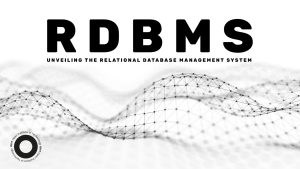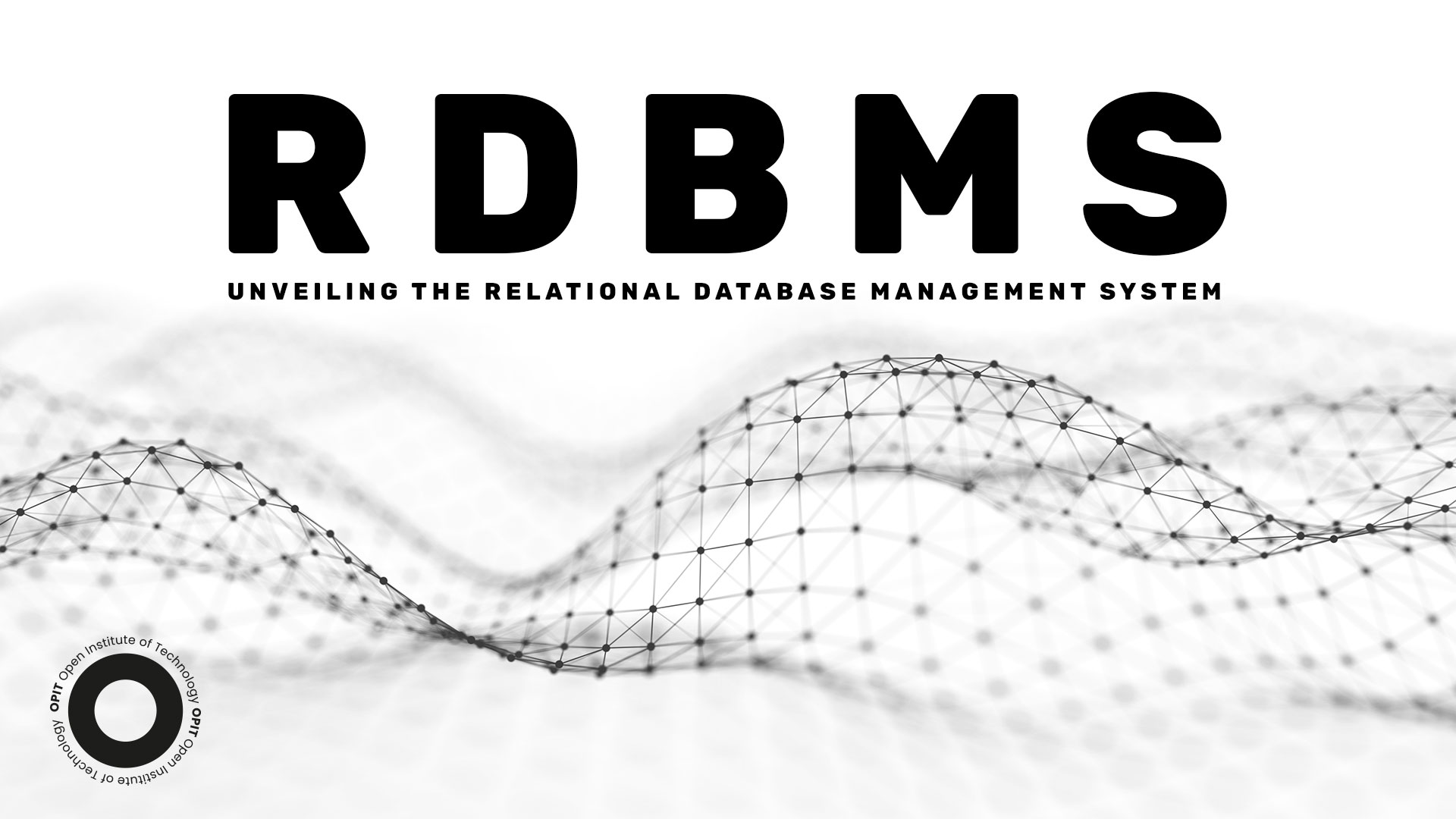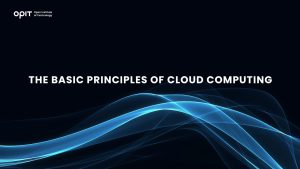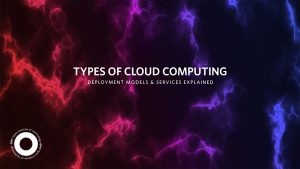

When you first get into modern computing, one of the terms that comes up most frequently is relational databases. These are clusters that are organized in such a way that they effortlessly find links between connected data points.
Relational databases are convenient, but what happens when you deal with vast amounts of information? You need something to act as your North Star, guiding you through the network and allowing you to stay on top of the data.
That something is an RDBMS. According to Google, RDBMS stands for a relational database management system – software that sets up and manages relational databases. In its full form, it’s been the light at the end of the tunnel for thousands of companies due to its accuracy, security, and ease of use.
The definition and importance of RDBMSs are the tip of the iceberg when it comes to these systems. This introduction to RDBMS will delve a bit deeper by taking a closer look at the concept of RDBMS, the history of this technology, use cases, and the most common examples.
History of RDBMS
The concept of RDBMS might be shrouded in mystery for some. Thus, several questions may come up when discussing the notion, including one as basic as “What is RDBMS?”
Knowing the RDBMS definition is a great starting point on your journey to understanding this concept. But let’s take a few steps back and delve into the history of this system.
Origins of the Relational Model
What if we told you that the RDBMS concepts are older than the internet? It may sound surprising, but it’s true.
The concept of RDBMS was developed by Edgar F. Codd 43 years ago. He aimed to propose a more efficient way to store information, a method that would consume drastically less memory than anything at the time. His model was groundbreaking, to say the least.
E.F. Codd’s Paper on Relational Model
Codd laid down his proposal in a 1970s paper called “A Relational Model of Data for Large Shared Data Banks.” He advocated a database solution comprised of intertwined tables. These tables enabled the user to keep their information compact, lowering the amount of disk space necessary for storage (which was scarce at the time).
The rest is history. The public welcomed Codd’s model with open arms since it optimized storage requirements and allowed people to answer practically any question using his principle.
Development of SQL
Codd’s research paved the way for relational database management systems, the most famous of which is SQL. This programming language was also developed in the ‘70s and was originally named SEQUEL (Structured English Query Language). It was quickly implemented across the computing industry and grew more powerful as the years went by.
Evolution of RDBMS Software
The evolution of RDBMS software has been fascinating.
Early RDBMS Software
The original RDBMS software was powerful, but it wasn’t a cure-all. It was a match made in heaven for users dealing with structured data, allowing them to organize it with minimal effort. However, pictures, music, and other forms of unstructured information were largely incompatible with this model.
Modern RDBMS Software
Today’s RDBMS solutions have come a long way from their humble beginnings. A modern relational DBMS can process different forms of information with ease. Programs like MySQL are versatile, adaptable, and easy to set up, helping database professionals spearhead the development of practically any application.
Key Concepts in RDBMS
Here’s another request you may have for an expert in RDBMS – explain the most significant relational database concepts. If that’s your question, your request has been granted. Coming up is an overview of RDBMS concepts that explain RDBMS in simple terms.
Tables and Relations
Tables and relations are the bread and butter of all relational database management systems. They sound straightforward, but they’re much different from, say, elements you come across in Microsoft Excel.
Definition of Tables
Tables are where data is stored in an RDBMS. They’re comprised of rows and columns for easier organization.
Definition of Relations
Relations are the links between tables. There can be several types of relations, such as one-to-one connections. This form means a data point from one table only matches one data point from another table.
Primary and Foreign Keys
No discussion about RDBMS solutions is complete without primary and foreign keys.
Definition of Primary Keys
A primary key is the unique element of each table that defines the table’s rows. The number of primary keys in a table is limited to one.
Definition of Foreign Keys
Foreign keys are used to form an inextricable bond between tables. They always refer to the primary key of another table.
Normalization
Much of database management is akin to separating wheat from the chaff. One of the processes that allow you to do so is normalization.
Purpose of Normalization
Normalization is about restoring (or creating) order in a database. It’s the procedure of eradicating unnecessary data for the purpose of cleaner tables and smoother management.
Normal Forms
Every action has its reaction. For example, the reaction of normalization is normal forms. These are forms of data that are free from redundant or duplicate information, making them easily accessible.
Popular RDBMS Software
This article has dissected basic relational database concepts, the RDBMS meaning, and RDBMS full form. To further shed light on the technology, take a look at the crème de la crème of RDBMS platforms.
Oracle Database
If you want to make headway in the database management industry, Oracle Database can be one of your best friends.
Overview of Oracle Database
Oracle Database is the most famous RDBMS around. The very database of this network is called Oracle, and the software comes in five different versions. Each rendition has a specific set of features and benefits, but some perks hold true for each one.
Key Features and Benefits
- Highly secure – Oracle employs top-grade security measures.
- Scalable – The system supports company growth with adaptable features.
- Available – You can tap into the architecture whenever necessary for seamless adjustments.
Microsoft SQL Server
Let’s see what another powerhouse – Microsoft SQL Server – brings to the table.
Overview of Microsoft SQL Server
Microsoft SQL Server is a reliable RDBMS with admirable capabilities. Like Oracle, it’s available in a range of editions to target different groups, including personal and enterprise users.
Key Features and Benefits
- Fast – Few systems rival the speed of Microsoft SQL Server.
- Versatile – The network supports on-premise and cloud applications.
- Affordable – You won’t burn a hole in your pocket if you buy the standard version.
MySQL
You can take your business to new heights with MySQL. The following section will explore what makes this RDBMS a go-to pick for Uber, Slack, and many other companies.
Overview of MySQL
MySQL is another robust RDBMS that enables fast data retrieval. It’s an open-source solution, making it less complex than some other platforms.
Key Features and Benefits
- Quick – Efficient memory use speeds up the MySQL environment.
- Secure – Bulletproof password systems safeguard against hacks.
- Scalable – You can use MySQL both for small and large data sets.
PostgreSQL
Last but not least, PostgreSQL is a worthy contender for the best RDBMS on the market.
Overview of PostgreSQL
If you need a long-running RDBMS, you can’t go wrong with PostgreSQL. It’s an open-source solution that’s received more than two decades’ worth of refinement.
Key Features and Benefits
- Nested transactions – These elements deliver higher concurrency control.
- Anti-hack environment – Advanced locking features keep cybercriminals at bay.
- Table inheritance – This feature makes the network more consistent.
RDBMS Use Cases
Now we get to what might be the crux of the RDBMS discussion: Where can you implement these convenient solutions?
Data Storage and Retrieval
- Storing large amounts of structured data – Use an RDBMS to keep practically unlimited structured data.
- Efficient data retrieval – Retrieve data in a split second with an RDBMS.
Data Analysis and Reporting
- Analyzing data for trends and patterns – Discover customer behavior trends with a robust RDBMS.
- Generating reports for decision-making – Facilitate smart decision-making with RDBMS-generated reports.
Application Development
- Backend for web and mobile applications – Develop a steady web and mobile backend architecture with your RDBMS.
- Integration with other software and services – Combine an RDBMS with other programs to elevate its functionality.
RDBMS vs. NoSQL Database
Many alternatives to RDBMS have sprung up, including NoSQL databases. But what makes these two systems different?
Overview of NoSQL Databases
A NoSQL database is the stark opposite of RDBMS solutions. It takes a non-relational approach, which is deemed more efficient by many.
Key Differences Between RDBMS and NoSQL Databases
- Data model – RDBMSs store structured data, whereas NoSQL databases store unstructured information.
- Scalability – NoSQL is more scalable because it doesn’t require a fixed schema (relation-based model).
- Consistency – RDBMSs achieve consistency through rules, while NoSQL models feature eventual consistency.
Choosing the Right Database for Your Needs
Keep these guidelines in mind when selecting your database platform:
- Use an RDBMS for centralized apps and NoSQL for decentralized solutions.
- Use an RDBMS for structured data and NoSQL for unstructured data.
- Use an RDBMS for moderate data activity and NoSQL for high data activity.
Exploring the Vast Utility of RDBMS
If you’re looking for a descriptive answer to the “what is relational database management system question,” here it is – it is the cornerstone of database management for countless enterprises. It’s ideal for structured data projects and gives the user the reins of data management. Plus, it’s as secure as it gets.
The future looks even more promising. Database professionals are expected to rely more on blockchain technology and cloud storage to elevate the efficacy of RDBMS.
Related posts

Life is unpredictable. While many of us have specific hopes and expectations of how our futures will turn out, things don’t always go as expected. There are many variables and unexpected incidents that can interfere and force you to alter your plans, and this is particularly true when it comes to education.
For instance, you might have had plans to study a specific subject, but had to deviate from those plans due to unforeseen circumstances. Or you may have had to enter the workforce in an occupation different from the one you sought in an effort to earn an income, a move that may not provide you with the time or opportunity to achieve your desired educational aims.
In short, every individual’s career pathway is different, and very few go exactly as we expect from the outset. Fortunately, even if you experience a few false starts or sudden twists in your pathway, there are always options available to help you get back on track.
The Unpredictable Nature of Education
In theory, the educational process seems simple. You select a course of study that interests you from the vast array of subjects and prospective professions, select the appropriate classes, acquire the knowledge and skills you need to succeed, and then embark on your profession.
In reality, however, as many people know from firsthand experience, the road to education is often far from straightforward. Here are just some of the many challenges that can take your educational path in a completely different direction:
- Life’s Curveballs: As touched on in the introduction, life is impossible to predict. Financial hardships, health issues, and family emergencies are just some of the unfortunate occurrences that might derail even the most perfectly planned educational regime.
- Changing Interests: People’s desires and preferences don’t necessarily stay the same throughout their entire lives. As you grow, learn, and have new experiences, your interests may change, and so, too, may your educational objectives.
- Pressure and Burnout: Some academic paths are particularly challenging, demanding intense levels of study and hard work. This can sometimes prove too much to bear, even for the most resilient students.
- Failures and Setbacks: Conventional education largely builds around tests and examinations, requiring students to demonstrate their competencies repeatedly. It’s a system that doesn’t suit everyone, and test failures can lead to setbacks and delays.
- Inequality: People can be born with very different privileges and levels of access to education. Those in certain parts of the world may find it much more challenging to complete their education path for financial, cultural, or even political reasons.
- Late Bloomers: People develop at different paces. Some may struggle educationally early on in their lives, forcing them to make certain concessions or sacrifices related to their studies, only to find their feet later in life once they’ve entered the world of work.
Whether you’re a late bloomer, have had your educational aspirations delayed by personal problems, desire to learn new skills and try something different, or want to begin a fresh chapter in your professional life, the Open Institute of Technology (OPIT) may be able to help.
Introducing OPIT
OPIT is an online teaching platform, making high-level technological educational programs accessible to all, no matter their age or background. Offering education in fields like computer science, artificial intelligence, and digital business, OPIT provides a curated collection of degrees. In addition, they offer classes taught by world-leading tutors imparting the wisdom and skills students need to achieve their goals and become the tech leaders of tomorrow.
Meanwhile, for those who have had somewhat tumultuous or unpredictable educational paths, OPIT offers the perfect course corrector: the OPIT Foundation Year.
The OPIT Foundation Year
OPIT’s Foundation Year is a Pre-Tertiary Certificate in Information Technology, fully aligned with MQF/EQF Level 4 standards and valued at 60 ECTS credits. Lasting just one year, this program essentially serves as a comprehensive yet accessible springboard towards higher-level education, creating a path towards degrees and careers in dynamic, flexible fields, like computer science and digital business.
Like other OPIT programs, the Foundation Year is delivered entirely online via the OPIT Virtual Learning Environment. Combining live lectures, asynchronous content, and interactive assessments, students enjoy diverse and dynamic study experiences, acquiring core skills like academic writing, mathematics, and computer literacy, and building a bedrock of knowledge and confidence before taking their next steps.
Who Is the Foundation Program For?
The Foundation Program is designed to provide a solid base upon which to build the technological education many students need. It’s the perfect choice for those who are eager and ambitious to enter professions in AI, data science, and computing, but don’t feel that they have the necessary core skills and knowledge needed to dive straight into a degree.
Entry requirements are relatively relaxed in order to allow as many students as possible to enjoy the benefits of this program. With that said, applicants should ideally hold an MQF/EQF Level 3 or equivalent qualification, with the intention of pursuing a bachelor’s degree. A minimum of B2 level of English proficiency is also required, as this is the working and studying language of the institution.
What the Foundation Year Provides
Perhaps you’ve recently graduated, are considering a career change, or finally have the opportunity to return to education after initial delays or unexpected disruptions to your original plans. Either way, the Foundation Year can help you enjoy:
- Greater Self-Confidence: Foundation Year graduates gain the fundamental skills they need to enter degree programs with much more self-belief and assuredness.
- Superior Tech Knowledge: Lasting two terms, this course explores mathematics, academic reading and writing, and provides an introduction to computer hardware and software.
- Foundational Mathematics: Mathematics literacy forms a large part of the study focus for the Foundation Year, helping students feel more comfortable with numbers and formulas.
- Flexible Learning: Unlike more rigid, conventional education environments, OPIT gives you the freedom and flexibility to study at a pace that suits you best, all from the comfort of home.
- Global Community: OPIT is an international institution, with staff and students from all around the world eager to share knowledge, exchange ideas, and help one another.
Take Your Next Steps to Success With the OPIT Foundation Year
If you’re curious about a career in technology or have always wanted to work with AI, data, and computers, but struggled to find the time and opportunities you need to acquire relevant skills and knowledge, the Foundation Program was made for people like you.
It’s the ideal entry point into the exciting world of online education, and the perfect first step towards a prestigious degree from an innovative and increasingly successful institution. Download the brochure to learn more about it, or start your online application, today.

Students today have a broader range of fields of study to choose from than ever before, but with the world becoming increasingly technological and computers increasing in influence and importance, pursuing a career in computer science often proves a smart, strategic choice.
There are numerous benefits and career paths associated with studying and working in computer science, and we’ll be listing just a few of them in this guide.
High Average Salaries
With the rising cost of living in many parts of the world, it’s unsurprising that many students are thinking several decades ahead to determine what level of starting salaries they could obtain in different career fields.
Many are also seeking professions that offer the opportunity for growth and the ability to advance up the ranks over time, thus increasing their salary and their quality of life in the process.
If a strong, stable salary with the opportunity for improved income is one of your top career priorities, computer science should be at or near the top of your list of prospective careers.
According to recent data, computer scientists earn an average of over €65,000 per year, with certain jobs, like IT project leader and data scientist, paying ever higher. Starting salaries are strong, too, with graduates earning anywhere from €46,000 to €60,000, depending on their chosen profession and level of qualifications.
There are similarly high average salaries reported around the world in computer science and related fields such as data science and AI/ML engineering. These numbers are projected to increase in the years to come, pointing to computer science as a way for graduates to get off to the best financial start of any career.
Unrivaled Flexibility
A common problem with some subjects and courses is that they only provide graduates with a narrow set of skills and a similarly narrow range of potential professions to which they can apply those skills.
That’s not the case with computer science. Graduates in this field can enjoy instant access to a remarkably diverse array of career opportunities, with even newer opportunities being created all the time as technology evolves and innovations emerge.
A few of the many industries and roles you might choose to enter in the field of computer science include:
- Healthcare: As a software developer, data analyst, or cybersecurity expert
- Finance: As a fintech engineer, blockchain developer, or security analyst
- Media: As a graphics programmer, AI developer, or game developer
- Education: As an analyst, software developer, or machine learning engineer
Guaranteed Opportunities
Some career paths are more limited than others, with relatively low numbers of opportunities, recurring risks of job loss, or difficulty obtaining employment in the first place.
Again, with computer science, this simply isn’t the case. At a time when 75% of companies plan to embrace AI and other technologies by 2027, and businesses of all sizes and industries are now relying on computers more than ever before, computer science graduates can enjoy almost unbeatable job security.
Opportunities will continue to grow for people with good computing knowledge, whether that be in the obvious fields like software and web development, engineering, and AI development, or more niche sectors.
With so many options, you’re effectively guaranteed a long, rewarding career if you put in the necessary time and effort needed to establish a strong foundation of computing skills.
Rapidly Expanding and Evolving Industries
It’s no secret that the world of technology is a dynamic and fast-moving one. In the past 20 years alone, we’ve seen the proliferation of the internet, the rapid advancement of smartphones and wearable devices, the emergence of AI, and so much more.
In the years ahead, engineers and developers will continue to explore the boundaries of modern technology’s powers and potential, driving new innovations and improvements and opening more exciting job opportunities for those already established and experienced in this field.
Getting into computer science now could therefore provide a solid foundation for a career filled with excitement as you uncover and explore new ways of working with computers in fields as diverse as healthcare, finance, education, entertainment, manufacturing, logistics, and beyond.
Start Your Computer Science Career at OPIT
We’ve discussed some of the many benefits associated with careers in computer science, from the high starting salaries to the rapidly growing array of job options available to graduates. By now, you may be eager to follow this particular career path and take advantage of the wealth of opportunities.
If you’re wondering how to start, the Open Institute of Technology (OPIT) may hold the answers you need. As an exclusively online learning platform, specializing in computer science and digital business, and staffed by some of the world’s leading tech experts, OPIT is producing the tech leaders of tomorrow.
Some of the many advantages of learning with OPIT include:
- Accessible and flexible online education that matches your learning style and schedule
- Heavy focus on real-world applications of the skills you acquire
- An international community of like-minded students from around the globe
- A top team of tutors and lecturers from varying fields and industries
- Progressive assessment of skills and understanding – not constant exams
OPIT offers a small, curated selection of courses for those seeking to gain the technological skills and knowledge to succeed in their chosen areas of expertise. That includes a BSc (Hons) in Computer Science – a six-term program, worth 180 ECTS credits.
Numerous IT industry leaders and experts helped develop this fully accredited undergraduate degree, which is online and accessible to all. Like other OPIT courses, it offers a flexible learning program, with progressive assessments, fast-track options, and the opportunity to be part of a growing community of learners and tutors.
If the benefits of doing a career in computer science interest you, download the OPIT BSc in Computer Science brochure or fill out an online application today and take your first step toward a rewarding and fulfilling profession.
Have questions?
Visit our FAQ page or get in touch with us!
Write us at +39 335 576 0263
Get in touch at hello@opit.com
Talk to one of our Study Advisors
We are international
We can speak in:


